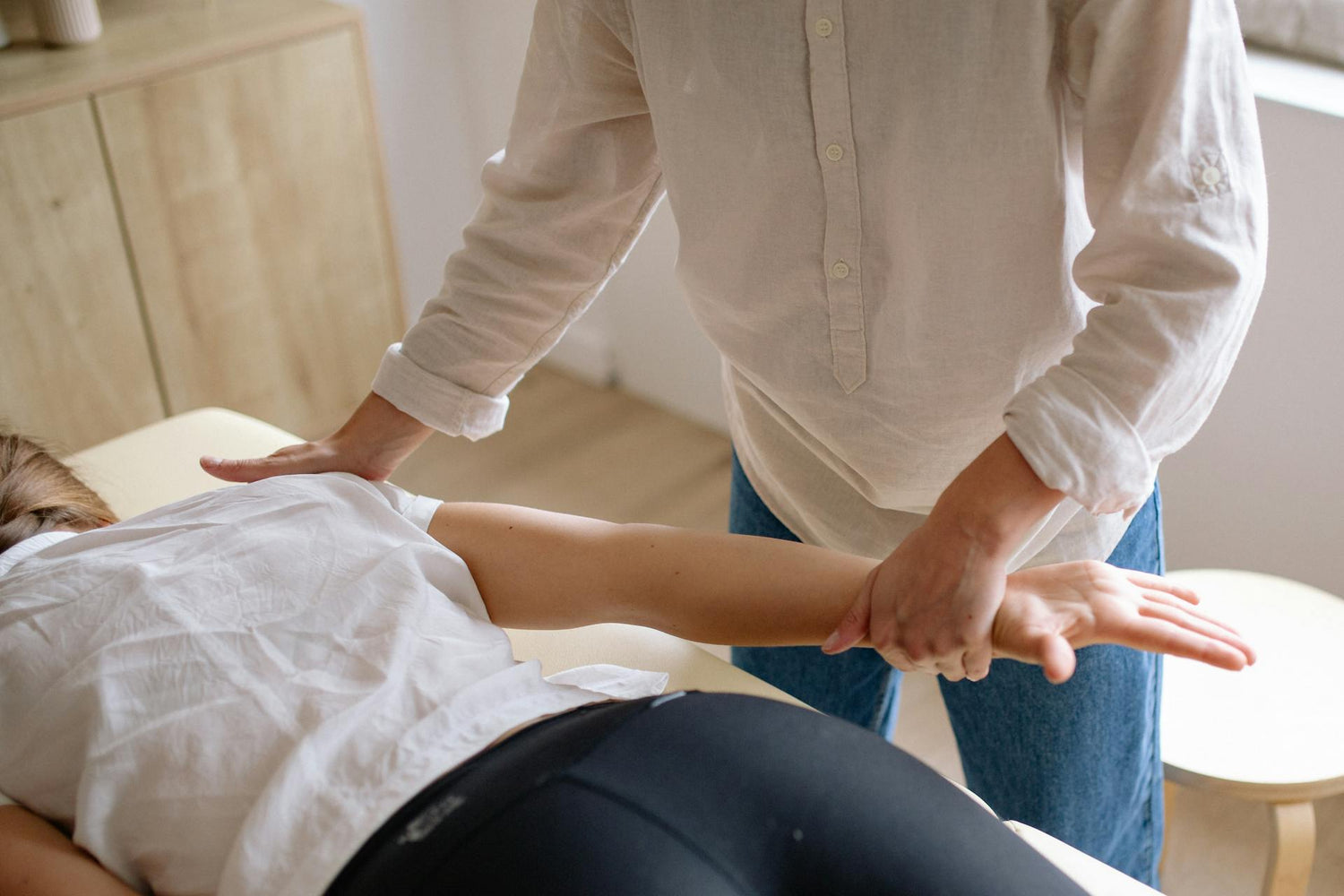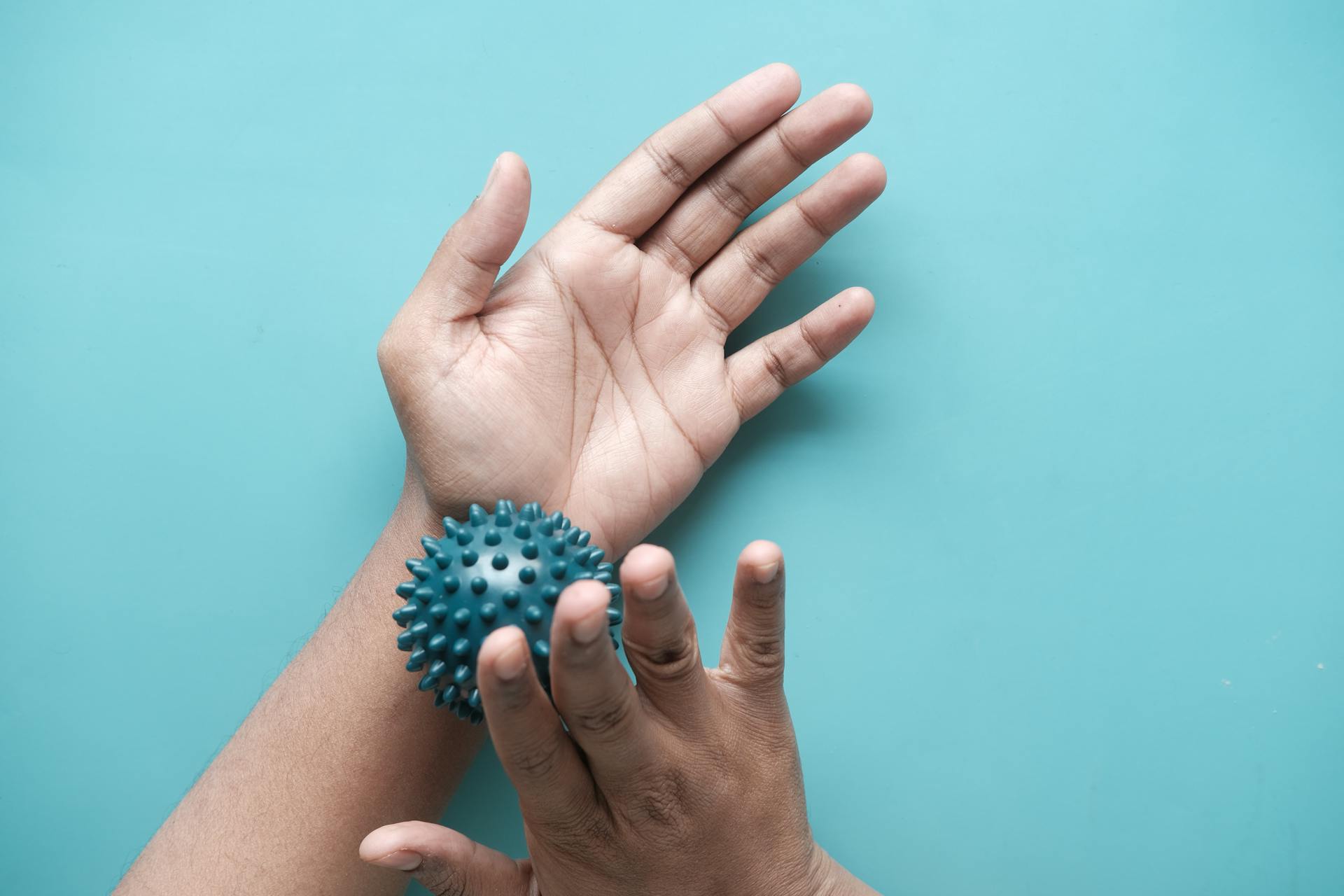Many of us have been there: You’re playing a round at your local golf course, and as you make your way to the last hole, you notice a sharp pain radiating from your inner elbow.
This pain is known as golfer’s elbow, and it can happen from overuse and damage to the tendons in your arm. Fortunately, a massage could offer you some much-needed relief.
Here’s what you should know about massage for golfer's elbow, including the benefits, how it works, and the best techniques to support your recovery.
What Is Golfer’s Elbow?
Golfer’s elbow is a condition that causes pain in the inner (or medial) elbow. It will affect less than 1% of the population, making it slightly less common than its better-known counterpart, tennis elbow. The official name for golfer’s elbow is medial epicondylitis.
So, how does golfer’s elbow happen?
In your arm, several large tendons connect to the tiny, bony bump in your inner elbow. These tendons help to flex the palm of your hand inward during certain activities — like when you’re swinging a golf club or clenching your fist.
When you overuse your arm, you can wind up with tiny tears in these tendons. And over time, this damage can lead to pain known as golfer’s elbow.
Aside from golf or racket sports, here are some other activities that can lead to this condition:
- Lugging around a heavy suitcase
- Weightlifting
- Throwing objects
- Rock climbing
- Certain occupations, such as working in an assembly line, painting, construction, or plumbing
How Do I Know If I Have Golfer’s Elbow?
Golfer’s elbow can feel like inflammatory pain that starts at the inner elbow and extends downward. It can also cause general muscle stiffness in your arm.
Beyond that, it’s more likely to happen when you overuse your arm — whether that’s at work or while playing a sport.
Simple, day-to-day activities can hurt or feel uncomfortable when you have this condition. These include:
- Twisting a doorknob
- Using your computer
- Balling your hand into a fist
- Any type of swinging motion
- Flexing your palm inward
Who Gets Golfer’s Elbow?
Most of the time, people with golfer’s elbow may work a job or play a sport that includes a lot of swinging, hammering, or gripping. They may also have certain risk factors, such as being over 40 years old, having obesity, or smoking.
Golfer’s Elbow Treatment
When you visit a doctor’s office, you may go through a few tests and questions to verify that you have golfer’s elbow. For example, your physician may put pressure on your arm or ask you to perform certain movements to test your range of motion. Then, they’ll ask you to report back on any pain or discomfort.
Treatments can range from simple exercises to surgery. But the good news is that most of the usual treatments are non-invasive. Your healthcare provider might recommend a simple mix of:
- Decreasing the activity that caused the damage. This is the first step in giving your tendons and muscles a chance to heal.
- Non-steroidal anti-inflammatory drugs (NSAIDs). Options like Tylenol or ibuprofen can help you manage your aches and pains through recovery.
- Using a brace for extra support.
- Icing to reduce inflammation.
- Range-of-motion exercises to strengthen the tendons and muscles in the forearm.
- Shock wave or ultrasound therapy to support circulation and healing.
If your golfer’s elbow has been bothering you for a while, your doctor may suggest corticosteroid injections to reduce inflammation and pain. You can also talk to your physician about trying alternative therapies, such as platelet-rich plasma (PRP) injections or prolotherapy.
How Long Does Golfer’s Elbow Last?
The time it takes to recover from golfer’s elbow can vary depending on your unique case. But most of the time, people start feeling better within six weeks to a few months.
How Does Massage Help Golfer’s Elbow?

If the usual resting and icing routine isn’t cutting it, massage can be well worth a try to relieve your pain. A good massage can soothe muscle tension that might be adding to your stiffness and discomfort. On top of that, it can reduce physical stress and support healing.
While massage has many wellness benefits, there hasn’t been much research on it for golfer’s elbow specifically. But one small study compared the results of ultrasound alone versus ultrasound and massage therapy for 20 patients with golfer’s elbow.
The results showed that kneading and friction massage boosted the results of the treatment, with the experimental group reporting better function and less pain after week two.
Golfer’s Elbow Massage Techniques
Here are four soothing ways to try massage for golfer's elbow at home:
Note: These techniques are intended as general information and should not substitute for personalized medical advice. Be sure to check with a doctor if you have chronic or severe golfer’s elbow and are in search of treatment.
Cross-Fiber Friction Massage
Cross-fiber massage, also known as deep transverse friction massage, is an easy at-home option to try on your inner elbow. Some believe it can promote collagen health, boost healing, and prevent adhesions in the tendons.
Here are the steps:
- Using your pointer and middle finger or your thumb, gently feel around your inner elbow for tender spots. Typically, you’ll find them a few inches away from the bony bump in your elbow.
- Then, gently rub the area from side to side. The fibers here run lengthwise, up and down your arm. You’ll want to make sure you knead across them for a cross-fiber massage.
- Work your way up to a moderate amount of pressure. It’s normal to feel some discomfort at first, but it should subside after a minute or two. If it doesn’t (or if it becomes painful), it’s best to stop and try massage another day.
- Repeat these steps for up to 10 minutes at a time. Or, you can try a few short, 5-minute bouts throughout the day.
Self-Massaging the Lower Forearm Muscles
For more all-around relief, you can try an easy self-massage for your lower forearm.
Here’s how to get started:
- Have a seat on a couch, bed, or comfortable chair.
- Place a pillow on your lap and rest your affected arm on top of it.
- Gently squeeze your affected forearm with your other hand.
- Then, using your body weight and maintaining good posture, lean in and repeat the squeeze. By doing this, you can use the force of your body to bring more pressure to the massage.
- Continue to knead your upper forearm muscles. You can twist your palm upwards and downwards to reach different parts of the muscle and soft tissue.
- For deeper relief, you can cross your unaffected arm on top of your affected arm and massage it with the side of the bone. Here is a video guide to make things easier.
Try a Simple Massage Ball

A massage ball is an excellent tool for massaging your muscles without tiring out your fingers. It can target a broader area of muscle tissue or work out specific trigger points, depending on how you want to use it.
Here’s how to use one for inner elbow pain:
- Sit at a table or desk, and place your ball on the surface. You could use a designated massage ball, but a tennis or lacrosse ball will also work well.
- Place your arm on the massage ball so that your inner elbow muscles are resting on top of it.
- Gently roll your arm back and forth for 30 seconds. This warms up your muscles to prepare them for deeper work.
- Increase the pressure as it feels best to you. Continue to roll forward, backward, and in circular motions for several more minutes.
- Repeat up to a few times per day.
Using a Massage Gun to Release Tension
Massage guns use short bursts of pressure — kind of like mini hammering motions — to massage your muscles.
At first, these tools might seem a bit too intense for something like golfer’s elbow. But if you use one correctly, it can be one of your best options for relief.
Here’s how to get started:
- Attach a light, round, airy head to your massage gun.
- Turn the gun to the lowest setting.
- Holding the massage gun at an angle, glide it along the muscles on your upper and lower arm for 20 to 30 seconds. This can help you ease tension above and below your elbow.
- Adjust the pressure to your desired setting, and work your way closer to your problem area while avoiding any bones and the crux of the arm. Continue to hold the device at an angle.
- Repeat for up to two minutes. Because these tools are so powerful, you won’t need to use one for too long.
Other Types of Massage for Golfer's Elbow
The self-massage tips above can work wonders when you need quick relief after an 18-hole round of golf.
But if you’re dealing with a longer-term or more problematic case of golfer’s elbow, you may need more professional help — and that’s where a massage therapist can come in. A licensed masseuse may use massage techniques such as:
Sports Massage
Sports massage therapy is a modality that focuses on athletic performance. When you visit a therapist to talk about golfer’s elbow, they’ll likely go over your current health status to check whether this massage is a good fit for you.
Then, they’ll use a combination of deep pressure, friction, and kneading motions to work on specific pain points.
Sports massage isn’t necessarily meant to be relaxing. Instead, it’s intended to prevent future injuries and promote healing.
Deep Tissue Massage
Deep tissue massage is a type of massage that uses effleurage, kneading, and trigger point release techniques to ease deep muscle tension. Unlike sports massage, deep tissue massage can help you reduce stress and discomfort while working on pain points.
Are There Any Risks of Massage for Golfer's Elbow?
To most people, a massage session can sound like the perfect solution for aches and pains. But sometimes, it can be unhelpful or even harmful.
For example, it’s best to avoid massage when you have a skin infection or an acute, recent injury (like a muscle tear). In the same sense, you also shouldn’t massage an acute case of golfer’s elbow. Beyond that, specific medical conditions may not pair well with massage — such as blood clotting disorders, nerve injuries, or certain types of heart disease.
Massage is generally safe and soothing, but every person’s health is unique. So, be sure to check with your doctor if you have any conditions you aren’t sure about.
Be Mindful of Your Massage Pressure
It’s normal to feel sore after a deep tissue massage. But when done incorrectly, deep pressure can cause bruising or injury. This is why starting light and increasing pressure gradually is essential — especially with a condition like golfer’s elbow.
Overall, remember to listen to your body’s signals, and don’t hesitate to decrease the pressure if anything doesn’t feel right.
Other Tips for Golfer’s Elbow Relief
A massage is one way to get relief when your inner elbow feels stiff or painful. But there are also a few other tips that could speed along your healing process:
Rest and Ice
When you have an overuse injury, the natural first step is to rest — at least for a short while. This gives your body a chance to start its repair process after your initial injury.
If your arm feels inflamed during the resting phase, you can also use ice packs to reduce pain and swelling.
Try Golfer’s Elbow Exercises

Beyond massage, specific exercises can help you get back in action again. They can strengthen the muscles that support the inner elbow, increase the load that your arm can handle, and help you feel better long-term.
Some top physical therapist-recommended exercises include:
Wrist Flexion Isometric Exercises
A wrist flexion isometric exercise might sound complicated, but it’s actually fairly simple. Here are the steps:
- Rest your affected arm on a table or comfortable surface with your palm facing up.
- Ball your hand in a fist and flex your wrist inward to bring your hand up.
- To increase the resistance, you can push down on your fist with your opposite hand. Or, you could add some weight with a small dumbbell.
- Repeat this exercise for up to one minute at a time.
Forearm Extension Stretch
This stretch will challenge your arm in the opposite direction as the wrist flexion exercise. To get started:
- Stand or sit comfortably in a chair with your affected arm extended and your palm facing up.
- Using your other hand, pull your affected arm’s hand down and backward. As you do this, you should feel a stretch in the forearm.
- Hold the stretch for 30 seconds.
- Take a 30 to 45-second break.
- Repeat up to three times.
Preventing Future Golfer’s Elbow
Once your golfer’s elbow symptoms begin to subside, you might wonder: Now what? How can you ensure you never have to deal with this bothersome injury again?
Here are some tips to help you keep golfer’s elbow away in the future:
- Regularly stretch your forearms. This can help you reduce the stiffness and strain on your tendons.
- Use proper equipment and form. Improper technique can often lead to muscle or tendon damage. By using proper form, you can prevent unnecessary stress and injury.
- Take some time to warm up before intense physical activity. Going from zero to 100 can be hard on your joints, muscles, and tendons. So, be sure to stretch and get some light movement in before jumping into any sport or workout.
The Takeaway on Golfer’s Elbow Massage
Golfer’s elbow is a condition that affects the tendons in your inner elbow, and the pain it brings can interfere with your daily life. Thankfully, certain massage techniques can help you feel better during the healing process.
The right massage can break up muscle tension, soothe discomfort, and bring you some in-the-moment relief. And when you pair it with rest, ice, and specific exercises, you can count on getting back in action in no time.
Getting Started
Be sure to check with your physician before beginning a massage routine. They can provide advice tailored to your personal health and help you determine whether it’s right for you.
Once you’re ready to start finding relief, you can use your own hands, a massage ball, or even a therapeutic tool like the MedMassager Body Massager Plus or Accuvibe Mini.
View MedMassager’s home tools to get started today, or learn more about their many healing uses here.



